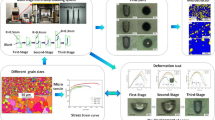Abstract
This work has established that a linear relationship exists between the change in Δr, the planar anisotropy, and the amount of true reduction strain imparted in the second cold reduction used to produce DR-9 product for drawn-and-redrawn cans. It also showed that a relationship exists between Δr and the degree of earing in the drawing of a cylindrical cup. The changes in Δr were also found to be consistent with the changes in crystallographic texture.
Similar content being viewed by others
References
R. L. Whiteley and D. E. Wise:Flat Rolled Products III, P. 47–61, Interscience, New York, 1962.
P. R. Mould and T. E. Johnson, Jr.: Sheet Metal Industries, Vol. 50, 1972, p. 328–348.
T. E. Johnson, Jr.: U. S. Steel Research Center, Monroeville, PA, unpublished research, 1982.
A. J. Klein and E. W. Hitchler: North American Tinplate Conference, Chicago, Illinois, October 16, 1985.
M. Fukuda: Trans. ISIJ, Vol. 8, 1968, p. 68–77.
Author information
Authors and Affiliations
Rights and permissions
About this article
Cite this article
Alworth, H.M., Michalak, J.T. & Shei, S.A. The effects of second cold reduction on the plastic anisotropy, crystallographic texture and earing behavior of DR-9 Tin-Mill product. J. Applied Metalworking 4, 327–330 (1987). https://doi.org/10.1007/BF02833943
Issue Date:
DOI: https://doi.org/10.1007/BF02833943



